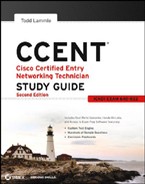Chapter 6
IP Routing
THE CCENT EXAM OBJECTIVES COVERED IN THIS CHAPTER INCLUDE THE FOLLOWING:
- Describe basic routing concepts (including: packet forwarding, router lookup process)
- Configure, verify, and troubleshoot RIPv2
- Perform and verify routing configuration tasks for a static or default route given specific routing requirements
- Interpret network diagrams
- Determine the path between two hosts across a network
- Describe the components required for network and Internet communications
 In this chapter, I'll discuss the IP routing process. This is an important subject to understand since it pertains to all routers and configurations that use IP. IP routing is the process of moving packets from one network to another network using routers. And as before, by routers I mean Cisco routers, of course!
In this chapter, I'll discuss the IP routing process. This is an important subject to understand since it pertains to all routers and configurations that use IP. IP routing is the process of moving packets from one network to another network using routers. And as before, by routers I mean Cisco routers, of course!
But before you read this chapter, you must understand the difference between a routing protocol and a routed protocol. A routing protocol is used by routers to dynamically find all the networks in the internetwork and to ensure that all routers have the same routing table. Basically, a routing protocol determines the path of a packet through an internetwork. Examples of routing protocols are RIP, RIPv2, EIGRP, and OSPF.
Once all routers know about all networks, a routed protocol can be used to send user data (packets) through the established enterprise. Routed protocols are assigned to an interface and determine the method of packet delivery. Examples of routed protocols are IP and IPv6.
I'm pretty sure that I don't have to tell you that this is definitely important stuff to know. You most likely understand that from what I've said so far. IP routing is basically what Cisco routers do, and they do it very well. Again, this chapter is dealing with truly fundamental material—these are things you must know if you want to understand the objectives covered in this book!
In this chapter, I'll show you how to configure and verify IP routing with Cisco routers. I'll be covering the following:
- Routing basics
- The IP routing process
- Static routing
- Default routing
- Dynamic routing
But the first thing I really have to do is really nail down the basics of how packets actually move through an internetwork, so let's get started!
 For up-to-the minute updates for this chapter, please see www.lammle.com/forum and/or www.sybex.com/go/ccent2e.
For up-to-the minute updates for this chapter, please see www.lammle.com/forum and/or www.sybex.com/go/ccent2e.
